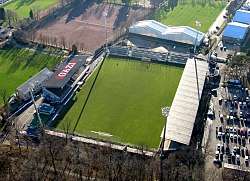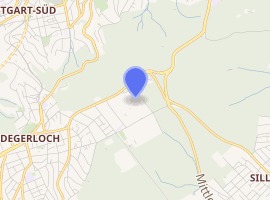Gazi-Stadion auf der Waldau
The Waldau-Stadion, known as the Gazi-Stadion auf der Waldau for sponsorship purposes, is a multi-use stadium in the Degerloch district in Stuttgart, Germany. The stadium is situated approximately 200m southwest of the Fernsehturm Stuttgart and holds 11,410 spectators (of these, 1,068 canopied seats and 4,949 canopied stands), which makes it the second biggest stadium in Stuttgart.[1] It is home to the Stuttgarter Kickers, as of 2013 playing in the 3. Liga. The American Football team Stuttgart Scorpions uses the stadium in the German Football League and, since 2008, the VfB Stuttgart II, also playing in the 3. Liga, plays its home games here.
 View from the Fernsehturm Stuttgart | |

| |
| Location | Guts-Muths Weg 4 70597 Stuttgart Germany |
|---|---|
| Coordinates | 48°45′14.2″N 9°11′18.3″E |
| Owner | City of Stuttgart |
| Operator | City of Stuttgart |
| Capacity | 11,410 (Total) 10,099 (Standing) + 1,311 (Seats) |
| Surface | Grass |
| Construction | |
| Built | 1905 |
| Opened | 18 June 1905 |
| Renovated | 1913, 1975, 1982, 1997, 2000, 2009 |
| Tenants | |
| Stuttgarter Kickers, Stuttgart Scorpions, VfB Stuttgart II | |
The Waldau-Stadion is the oldest stadium in Germany.[2]
History
The football section of Stuttgarter Kickers plays their home games in the stadium since its inauguration in 1905, thereby being the German club that plays for the longest time in the same stadium.
Until 1975, the stadium featured a wooden terrace that was built after one of Arsenal's in scale 1–3. Due to various requirements imposed by the German Football Association, a new main stand was built in 1976 and is in use until today. After having the names Kickers-Platz andKickers-Stadium since 1905, the stadium was officially renamed to Waldau-Stadion in 1987.[3]
The Stuttgart Scorpions use the stadium since their promotion to the German Football League in 1995.
In 2001, the MTV HipHop Open took place in the stadium. This was the only occurrence of the music festival in the stadium as it moved to the Reitstadion in the next year and has been moved to Mannheim since 2009.
In June 2004 the name of the stadium was sold to the German main sponsor Garmo AG for 10 years. Garmo sells its products with the brand name GAZi and renamed the stadium accordingly to GAZi-Stadion auf der Waldau.
On 6 October 2007, the final of the German Bowl, the German championship in American Football, between the Stuttgart Scorpions and the Braunschweig Lions took place in the GAZi-Stadion. Braunschweig won the championship for the third time in a row, defeating Stuttgart 27–6 in front of 8,152 spectators.
On 17 July 2008, Stuttgart's council decided to remodel the stadium for 5.4 million Euro in order to fulfill the requirements imposed by the DFB for the new 3. Liga. It was planned to increase the capacity to 12,000 spectators (2,000 canopied seats and 10.000 stands in total). Beginning of the construction work was planned for January 2009 and should be finished by July 2009.[4] In the end of 2008, however, the council decided to postpone the remodeling for an unknown time span. Following the relegation of Stuttgarter Kickers to the fourth-tier Regionalliga Süd, the remodeling would not have been necessary. VfB Stuttgart II, however, for now continues to host its home games in the 3. Liga in the stadium with a special approval by the DFB.
References
- "State Capital Stuttgart - Fassungsvermögen". State Capital Stuttgart Official Website. 2010. Archived from the original on 27 January 2010. Retrieved 7 June 2010.
- "Die Adolf-Jäger-Kampfbahn: Ein Denkmal stirbt". Hamburger Abendblatt (in German). 4 April 2015. Retrieved 24 April 2018.
- "Stadiongeschichte". Das Kickersarchiv (in German). Retrieved 7 June 2010.
- "Fußball – 3.Liga: Kickers-Stadion wird auf Vordermann gebracht". Focus (in German). 17 July 2008. Retrieved 7 June 2010.